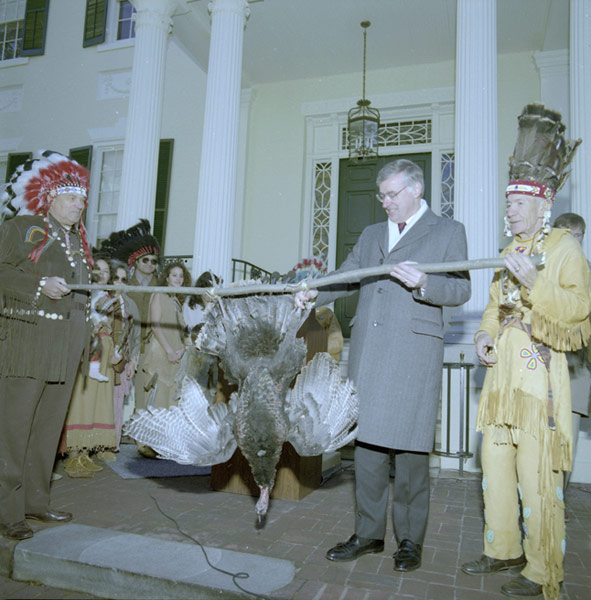Thanksgiving, a Tradition for Virginia Tribes
Virginia’s Indian tribes mark each Thanksgiving with a tradition dating back to the 1600s. Each Thanksgiving tribal members from the Mattaponi and Pamunkey journey to the Executive Mansion in Richmond, Virginia — home of the Governor — with an offering of wild game. The Governor presides over the annual ceremony, which is attended by about 200 people. This includes several generations of Native American people often dressed in traditional outfits, the families and children of Virginia state workers, and tourists who are in the capitol area. It was the ancestors of the Virginia Indian tribes who first greeted the European settlers in Jamestown in 1607, a few decades before the Wampanoag encountered the settlers and set the stage for the first Thanksgiving.

Indian Tribes Pay Tribute Taxes to Governor Baliles, 1989. From Prints & Photographs, Special Collections, Library of Virginia (Richmond, VA).
Today, only two Virginia tribes live on reservations: the Mattaponi and the Pamunkey, whose treaties predate the United States. The Mattaponi Reservation dates back to 1958. The tribe began paying a tribute of wild game to the Governor as early as 1946. The Pamunkey were one of 30+ tribes in the Powhatan Confederacy, which had 10,000 members. Reportedly, the Pamunkey Reservation dates back to 1607, making it “the” oldest reservation in the US. Chief Powhatan and Pocahontas lived among the Pamunkey, who today have 100 members.
 Virginia tribes continue to make their annual offering to commemorate the peace treaty that was signed in 1677 by Lord Charles II (then King of Britain, France, and Ireland) and Herbert Jeffreys (then royal governor of the Virginia colony). During the signing of the treaty, Virginia Indian tribes agreed to “deliver to the governor of the colony ‘at the place of his residence, wherever it shall be’ 20 beaver skins.” Since then the tribute has included deer, geese, turkey, fish, and other wildlife, which is sometimes donated to a Virginia group that feeds the hungry. The treaty was after all an “agreement,” and so the tribes keep their word to the state.
Virginia tribes continue to make their annual offering to commemorate the peace treaty that was signed in 1677 by Lord Charles II (then King of Britain, France, and Ireland) and Herbert Jeffreys (then royal governor of the Virginia colony). During the signing of the treaty, Virginia Indian tribes agreed to “deliver to the governor of the colony ‘at the place of his residence, wherever it shall be’ 20 beaver skins.” Since then the tribute has included deer, geese, turkey, fish, and other wildlife, which is sometimes donated to a Virginia group that feeds the hungry. The treaty was after all an “agreement,” and so the tribes keep their word to the state.
To me, it has always been a mystery why Virginia tribes do not have federal recognition. The State of Virginia recognizes eight tribes: The Chickahominy, Eastern Chickahominy, Monacan, Nansemond, Rappahannock, Mattaponi, Upper Mattaponi, and Pamunkey. These tribes ushered in the earliest Europeans and yet they somehow are not recognized as “tribes” by the federal government. How does this make sense? It’s like asking, “was Pocahontas Indian?”
As Governor Timothy Kaine noted at the 2009 Thanksgiving tribute, “The tribes of Virginia were really the first in this new world that showed what our traditions of hospitality and welcome were.” Tribes such as the Rappahannock Indians have worked ardently for decades to gain federal recognition. Before Kaine left office, a bill to recognize the Virginia tribes passed the U.S. House of Representatives and a voice vote by a Senate committee. But sadly, this effort failed and as of April 2011, the Virginia tribes were still petitioning for federal status.
The lack of federal recognition has restricted Virginia tribal members from participating in federal benefits such as healthcare, education, and housing. It is my sincere hope that one day the US will come to a point of thanksgiving for the contributions of these tribes, and that these tribal members will enjoy all the federal benefits that they paid for so dearly with their lands and their lives.


5 Comments
I blog frequently and I seriously thank you for your content.
Your article has really peaked my interest.
I’m going to bookmark your website and keep checking for new details about once a week. I opted in for your RSS feed too.
Great article, totally what I wanted to find.
This website was… how do you say it? Relevant!
Finally I’ve found something which helped me. Cheers!
I don’t agree with this specific write-up. Nevertheless, I did researched in Google and I’ve discovered out that you are correct and I had been thinking within the incorrect way. Continue producing quality material comparable to this.
Can I simply just say what a comfort to find a person that truly
knows what they’re talking about on the net. You definitely understand how to bring a problem to light and show it important. A lot more people ought to check this out and understand this side of your story…
One Trackback
[…] http://www.blackcommentator.com/66/66_cover_thanksgiving_pf.html http://www.dailykos.com/story/2006/11/23/273864/-The-Thanksgiving-Day-Massacre-Or-would-you-like-Turkey-with-your-genocide http://www.colonialwarsct.org/1637.htm http://www.republicoflakotah.com/2009/cooking-the-history-books-the-thanksgiving-massacre/ http://www.mashantucket.com/tribalhistory.aspx http://www.native-languages.org/wampanoag_culture.htm http://www.schemitzun.com/gcphome.aspx http://www.easternpequottribalnation.com/history.html https://decolonization.wordpress.com/tag/settler-colonialism/ http://www.nativeweb.org/pages/legal/thanksgiving_nelte.html http://www.manyhoops.com/cranberries.html http://www.texasalmanac.com/topics/history/timeline/first-thanksgiving http://www.oldcity.com/city-blog.php?id=38 http://blog.nrcprograms.org/thanksgiving-a-tradition-for-virginia-tribes/ […]